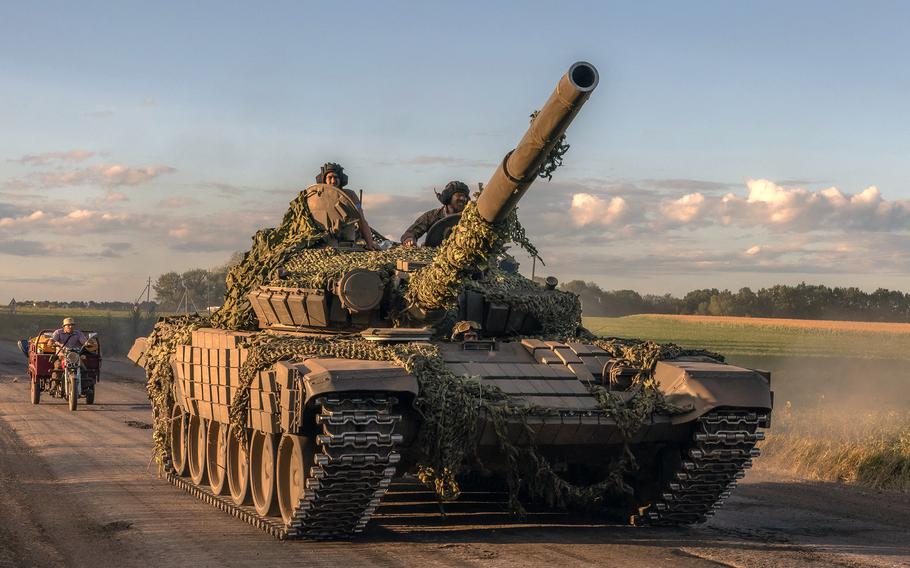
Ukrainian troops operate a Soviet-made T-72 tank in the Sumy region, near the border with Russia, on Aug. 12, 2024, amid the Russian invasion of Ukraine. Ukraine launched a surprise offensive into the Russian border region of Kursk on Aug. 6, 2024. (Roman Pilipey, AFP via Getty Images/TNS)
(Tribune News Service) — For most of the year, the Ukrainian army has been in a defensive crouch across the more than 600-mile-long front line. It has been dealing with a Russian opponent whose use of glide bombs, artillery and so-called meat assaults — waves of Russian troops moving toward a position to overwhelm the defenders — has caused problems within the ranks.
Beginning peace talks with Moscow, a subject many Ukrainians viewed as taboo, is now being discussed publicly as a policy option. And while the Russians haven’t picked up swaths of territory like they did in the first few months of the war, their relentless offensive in Donbas over the last several months has forced Ukrainian President Volodymyr Zelenskyy to streamline procedures for mobilizing new men into the army.
The last week, however, has seen the tables turn. Even as the Russians continue to blast Ukrainian positions in the east of the country, at least 1,000 Ukrainian troops have executed a sneak attack across the border into Russia’s Kursk region.
This isn’t the first time the Russians have had to defend small villages along the border with Ukraine. But the current attack is notable because the Ukrainians appeared to have taken Moscow by surprise. The Ukrainians have captured dozens of smaller villages in Kursk, forced Russian authorities to evacuate tens of thousands of people and caused panic in Moscow. At the time of writing, the Ukrainian offensive reached about 20 miles into Russia.
Despite the Russian Defense Ministry claiming that everything is under control, the Ukrainian thrust is another highly public humiliation for a Russian army that was generally viewed as lethal, competent and prepared before the war in Ukraine began.
The situation looks mightily different today. The Russian army is certainly lethal, as Ukrainians can testify to, and yet the sheen has worn off in terms of competence; nobody monitoring the war can argue differently with a straight face. The foibles, screw-ups and mishaps — a failed Russian offensive in Kyiv, an embarrassing withdrawal in Kharkiv, a mercenary coup in Russia that came to within 150 miles away from Moscow, incessant hatred within the Russian army’s lower ranks for their own generals — are too many to cover in a single column.
Even so, what Russians do have is mass. Frankly put, they have more of everything, which is precisely why Moscow has been able to keep this conflict going despite at one point suffering an astounding 70,000 casualties over two months. Whereas the Ukrainians have the motivation and the tactical skill, the Russians have the bodies and lead. And therein lies the main issue for the Ukrainian government: How can it prevail facing an adversary with such materiel advantages?
Kyiv has apparently come to the conclusion that shaking things up and catching Moscow off guard, on its own territory, no less, is one of those ways. Symbolically, the operation is paying off. Not many people are talking about the Russian offensive toward Chasiv Yar and Pokrovsk. The topic of conversation is now about how the Ukrainians have bloodied Russian President Vladimir Putin’s nose yet again.
Even so, it’s important during times like these to go beyond the emotional and focus on the practical. For instance, what is Ukraine actually trying to achieve with this offensive? What are the objectives? And are those objectives worth the costs to other areas of the front, particularly at a time when Ukraine’s new mobilization system is still getting off the ground?
The Ukrainians haven’t been straight about what they hope to achieve by invading Russian territory. Some have suggested that taking the fight directly to the enemy is meant to give the grunts in the trenches a renewed sense of hope after months in which they’ve been bombarded by all manner of Russian ordnance. Others have given a more military-specific rationale for the operation — by creating a new front, the Russian army will have to devote more manpower and resources toward defending its own country, which will decrease pressure on Ukrainian forces on the front line.
Zelenskyy has been vague, merely stating that the offensive is designed to punish the Russian aggressor. Still others have said that Ukraine’s priority is to occupy a sliver of Russian territory over the long term, which would bolster Kyiv’s position at the negotiating table and perhaps convince Putin to minimize his expansionist desires.
Of all the suppositions offered, the last on the list is the most difficult to believe. First, there is no guarantee that Ukraine has the manpower to hold Russian land long enough for Putin to rethink his entire war strategy. The Russians have already dispatched aircraft, tanks and men farther south to drive the Ukrainians out of Kursk, and it’s likely only a matter of time before they do. Taking territory is one thing; holding it is another.
Ukrainian officials are no doubt smiling as they watch their troops hang Ukrainian flags in a few Russian towns, but there’s no disputing the fact that this entire offensive is a huge gamble on their part. Zelenskyy and Ukraine’s top general, Oleksandr Syrskyi, likely hoped Russia would deal with the situation by redeploying some troops from Eastern Ukraine.
But that doesn’t seem to be happening. The pace of Russian attacks on Ukrainian positions in this region has stayed the same. As one Ukrainian press officer told The New York Times this week, “Our guys do not feel any relief.”
Ukraine’s successes on Russian soil today could very well turn into a pyrrhic victory tomorrow.
Daniel DePetris is a fellow at Defense Priorities and a foreign affairs columnist for the Chicago Tribune.
©2024 Chicago Tribune. Visit at chicagotribune.com.
Distributed by Tribune Content Agency, LLC.